The tumor suppressor gene Trp53 protects the mouse lens against posterior subcapsular cataracts and the BMP receptor Acvr1 acts as a tumor suppressor in the lens
- PMID: 21504908
- PMCID: PMC3124053
- DOI: 10.1242/dmm.006593
The tumor suppressor gene Trp53 protects the mouse lens against posterior subcapsular cataracts and the BMP receptor Acvr1 acts as a tumor suppressor in the lens
Abstract
We previously found that lenses lacking the Acvr1 gene, which encodes a bone morphogenetic protein (BMP) receptor, had abnormal proliferation and cell death in epithelial and cortical fiber cells. We tested whether the tumor suppressor protein p53 (encoded by Trp53) affected this phenotype. Acvr1 conditional knockout (Acvr1(CKO)) mouse fiber cells had increased numbers of nuclei that stained for p53 phosphorylated on serine 15, an indicator of p53 stabilization and activation. Deletion of Trp53 rescued the Acvr1(CKO) cell death phenotype in embryos and reduced Acvr1-dependent apoptosis in postnatal lenses. However, deletion of Trp53 alone increased the number of fiber cells that failed to withdraw from the cell cycle. Trp53(CKO) and Acvr1;Trp53(DCKO) (double conditional knockout), but not Acvr1(CKO), lenses developed abnormal collections of cells at the posterior of the lens that resembled posterior subcapsular cataracts. Cells from human posterior subcapsular cataracts had morphological and molecular characteristics similar to the cells at the posterior of mouse lenses lacking Trp53. In Trp53(CKO) lenses, cells in the posterior plaques did not proliferate but, in Acvr1;Trp53(DCKO) lenses, many cells in the posterior plaques continued to proliferate, eventually forming vascularized tumor-like masses at the posterior of the lens. We conclude that p53 protects the lens against posterior subcapsular cataract formation by suppressing the proliferation of fiber cells and promoting the death of any fiber cells that enter the cell cycle. Acvr1 acts as a tumor suppressor in the lens. Enhancing p53 function in the lens could contribute to the prevention of steroid- and radiation-induced posterior subcapsular cataracts.
Figures
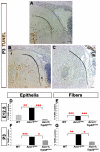

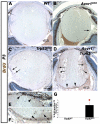
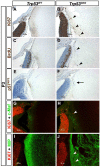


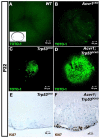
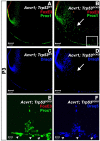
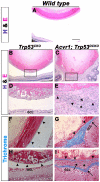

Similar articles
-
Functions of the type 1 BMP receptor Acvr1 (Alk2) in lens development: cell proliferation, terminal differentiation, and survival.Invest Ophthalmol Vis Sci. 2008 Nov;49(11):4953-60. doi: 10.1167/iovs.08-2217. Epub 2008 Jun 19. Invest Ophthalmol Vis Sci. 2008. PMID: 18566469 Free PMC article.
-
Aberrant lens fiber differentiation in anterior subcapsular cataract formation: a process dependent on reduced levels of Pax6.Invest Ophthalmol Vis Sci. 2004 Jun;45(6):1946-53. doi: 10.1167/iovs.03-1206. Invest Ophthalmol Vis Sci. 2004. PMID: 15161862
-
Lens fiber cell differentiation and denucleation are disrupted through expression of the N-terminal nuclear receptor box of NCOA6 and result in p53-dependent and p53-independent apoptosis.Mol Biol Cell. 2010 Jul 15;21(14):2453-68. doi: 10.1091/mbc.e09-12-1031. Epub 2010 May 19. Mol Biol Cell. 2010. PMID: 20484573 Free PMC article.
-
[The oxidative stress in the cataract formation].Nippon Ganka Gakkai Zasshi. 1995 Dec;99(12):1303-41. Nippon Ganka Gakkai Zasshi. 1995. PMID: 8571853 Review. Japanese.
-
Cortical and subcapsular cataracts: significance of physical forces.Ophthalmologica. 2006;220(1):1-5. doi: 10.1159/000089267. Ophthalmologica. 2006. PMID: 16374041 Review.
Cited by
-
A genetic variant in microRNA target site of TGF-β signaling pathway increases the risk of colorectal cancer in a Chinese population.Tumour Biol. 2014 May;35(5):4301-6. doi: 10.1007/s13277-013-1562-9. Epub 2013 Dec 29. Tumour Biol. 2014. PMID: 24375256
-
Ionizing irradiation not only inactivates clonogenic potential in primary normal human diploid lens epithelial cells but also stimulates cell proliferation in a subset of this population.PLoS One. 2014 May 19;9(5):e98154. doi: 10.1371/journal.pone.0098154. eCollection 2014. PLoS One. 2014. PMID: 24840866 Free PMC article.
-
Identification of Novel Gata3 Distal Enhancers Active in Mouse Embryonic Lens.Dev Dyn. 2018 Nov;247(11):1186-1198. doi: 10.1002/dvdy.24677. Epub 2018 Nov 10. Dev Dyn. 2018. PMID: 30295986 Free PMC article.
-
p53 E3 ubiquitin protein ligase homolog regulates p53 in vivo in the adult mouse eye lens.Mol Vis. 2013 Dec 8;19:2468-76. eCollection 2013. Mol Vis. 2013. PMID: 24339722 Free PMC article.
-
Lifetime study in mice after acute low-dose ionizing radiation: a multifactorial study with special focus on cataract risk.Radiat Environ Biophys. 2018 May;57(2):99-113. doi: 10.1007/s00411-017-0728-z. Epub 2018 Jan 11. Radiat Environ Biophys. 2018. PMID: 29327260 Free PMC article.
References
-
- Achison M., Hupp T. R. (2003). Hypoxia attenuates the p53 response to cellular damage. Oncogene 22, 3431–3440 - PubMed
-
- Almog N., Rotter V. (1997). Involvement of p53 in cell differentiation and development. Biochim. Biophys. Acta. 1333, F1–F27 - PubMed
-
- Atfi A., Baron R. (2008). p53 brings a new twist to the Smad signaling network. Sci. Signal. 1, pe33. - PubMed
Publication types
MeSH terms
Substances
Grants and funding
LinkOut - more resources
Full Text Sources
Other Literature Sources
Medical
Molecular Biology Databases
Research Materials
Miscellaneous

